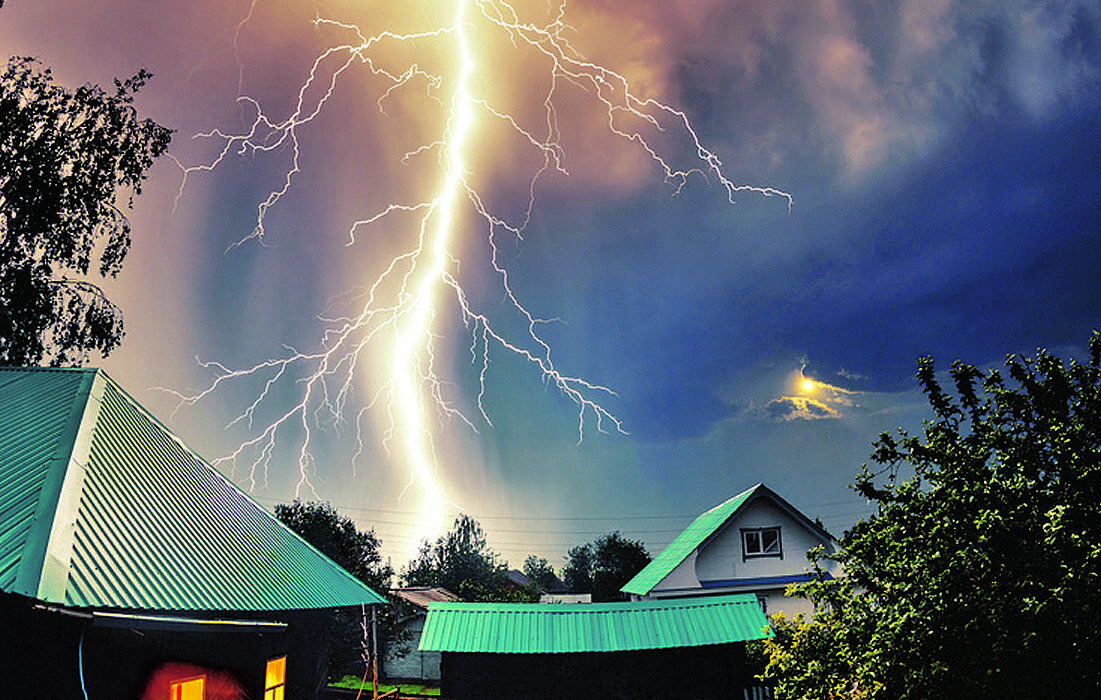This article was first published in the New Vision on January 27, 2021
Despite deaths of learners due to lightning strikes, most schools in the country remain without arresters
The rainy season that is usually characterised by lightning strikes will begin in one or two months’ time.
Over the years, Uganda has lost learners to lightning strikes in schools, partly because of lack of lightning arresters. Sources in the education ministry say 65% of the country’s schools do not have lightning arresters.
In 2019, about 70% of the schools in the country did not have lightning arresters and little effort has been made to reverse the status quo.
A lightning arrester is a metallic rod that is placed on a building and connected to the ground to protect the structure and its occupants from being stuck by lightning. In Uganda, buying and installing a lightning rod costs between sh1.5m and sh2.5m.
Silent danger
In April 2018, six pupils 0f Nyakeina Parents Primary School in Kanungu district, western Uganda, were killed after being struck by lightning.
The tragedy happened during an afternoon downpour as the pupils and their teachers attended a school debate. Seven pupils were admitted to Bwindi Community Hospital in Kayonza sub-county with burns and shock.
In 2017, lightning killed four other pupils at St Prisca Primary School in Hoima district. The victims were Macklin Kusemererwa (Primary Six), Jackline Karungi (Primary Five), Diana Kusiima (Primary Six) and Evelyn Kasemere (Primary Four). Such incidents should have acted as an eye-opener for the Government to install lighting arresters in schools.
The deadliest lightning strike was at Runyanya Primary School in Kiryandongo district that left 18 pupils and a teacher dead.
Government reports in the education ministry show the period between 2012 and 2015, over 400 school-going children were killed by lightning.
“We have left these issues to God. There are other equally critical funding gaps in our schools — the need for more teachers or even good buildings. We do not ask for the lightning arresters, not because they are not important, but because we have more problems to sort out,” a headteacher in a public school in Nakasongola district says.
At one time, disaster preparedness state minister Musa Ecweru proposed that lightning strikes be declared a national disaster.
In 2014, the Uganda National Meteorological Authority installed a lightning sensor in Entebbe to detect lightning and send warning signals before it strikes.

The antenna with multiple sensors can pick lightning data from the clouds using its remote sensing and process it before wiring it to telecom companies, who in turn will relay the warning to the target. It identifies the lightning-prone areas such as those around Lake Victoria, in the mountains and the Rift Valley.
Globally, about 24,000 people are killed by lightning strikes every year, and more 240,000 are injured in the same period.
More Funds Needed
Last year, the Government installed 136 lightning arresters in 136 schools around the country. However, as the Government plans the re-opening of schools, the education ministry reports show that many other schools are in dire need of lightning arresters.
The latest 2020 Budget Monitoring Accountability Unit reports indicate that a contract was signed between M/S Kata Technologies and Logistics to install lightning arresters in 136 primary schools at a cost of sh409m in 10 districts. The districts were Kasese (13), Butambala (13), Busia (13), Pallisa (13), Iganga (17), Luuka (13), Kole (13), Mubende (13), Kibaale (15) and Hoima (13). However, there seems to be limited funds to buy lightning arresters. In the last financial year, less than sh1b was released for lightning arresters.
However, if the Government was to buy lightning conductors at sh1.5m for all the 12,405 primary schools in the country, it would cost about sh18.6b. Between 2010 and 2011, the Office of the Prime Minister directed the education ministry to procure lightning conductors for all government-aided primary and secondary schools. This was at the peak of lightning strikes that killed many school-going children. However, officials in the education ministry say this was not done due to limited funds.

What government Says
The director for basic and secondary education in the education ministry, Dr Cleophus Mugenyi, says the number of schools without lightning arresters may not be more than 55%.
“We have supported 10 local governments in the last two financial years. In 2018/19 we covered 134 primary schools, and 136 for 2019/2020 we plan to cover 140 primary schools. We have limited resources to cover many schools,” he says.
Mugenyi says the education ministry also faces the challenge of theft and vandalism of lightning arresters in schools.
“These arresters are always stolen or vandalised by people in communities. We have asked schools to ensure they protect the arresters through community sensitisation and guarding school premises at night,” he says.
Mugenyi also adds that schools, through the ministry’s central procurement, do not have to advertise before buying the lightning arresters. “We now centrally procure them and ensure they are installed in the most prone schools.”
The higher education state minister, Dr Chrysostom Muyingo, says he is aware of the danger schools without arresters face.
“No school construction contract can now be approved without including the installation of lightning arresters on buildings. We will gradually ensure that all public schools’ buildings have lightning arresters,” the minister says.

Challenges
The 2020 budget monitoring report shows that emergency funds disbursed to schools and districts do not include money for adverts in the media (inviting bids for installation of the arresters).
“The education ministry often disburses the funds after districts have completed their procurement processes, thus constraining them in finding additional funds to make separate adverts for emergency construction projects.”
This means it becomes complicated to buy lightning arresters without advertising the bids in the media as required by law.
The change of procurement modality is affecting the installation of these lightning arresters.
“According to the Public Procurement and Disposal of Public Assets Act, primary schools are not allowed to handle procurements above sh20m. So, these procurements have to be done by the respective districts, which causes delays in implementation.”
More so, the report says: “The education ministry continues to be overwhelmed by the number of schools that require emergency funding amidst shortages. The projects do not have a component for monitoring and supervision, which makes monitoring of civil works difficult.”
How lightning strikes
Lightning strikes a building through wires or pipes that extend outside the structure or through the ground.
It can travel through the electrical, phone, plumbing or radio and television reception systems.
Lightning current also can travel through any metal wires or bars in concrete walls or flooring.
How it occurs

Weather experts say: “When air rises and falls within a thunderstorm, positive and negative charges form in the cloud. The bottom of the thundercloud has a negative charge, and the top has a positive charge.”
London’s National Lightning Safety Institute says a flash of lightning happens when a charge becomes so strong that the air cannot stop it from hitting the ground. Lightning can also form inside the cloud, moving between charged areas.
The institute adds that the average flash of lightning could turn on a 100-watt light bulb for more than three months.
Through wires or pipes that extend outside the structure or through the ground. It can travel through the electrical, phone, plumbing or radio and television reception systems. Lightning current also can travel through any metal wires or bars in concrete walls or flooring.
Safety measures one can take
London’s National Lightning Safety Institute advises that safe shelters are buildings with electricity and plumbing or metal-topped vehicles with the windows closed. Picnic shelters, dugouts and small buildings without plumbing or electricity are not safe. It lists indoor safety tips as follows.
- Stay off corded phones. You can use cellular or cordless phones. Do not touch electrical equipment such as computers, TVs or cords. Remote controls can be used safely.
- Avoid plumbing. Do not wash your hands, take a shower or wash dishes during storms. Stay away from exterior windows and doors that might contain metal components, leading from outside your home to the inside.
- Stay off balconies, porches and out of open garages or carports. Do not lie on concrete floors or lean against concrete walls.
- Protect your pets: Dogs that are chained to trees or on metal runners are particularly vulnerable to lightning strikes.
- Protect your property: Lightning generates electrical surges that can damage electronic equipment some distance from the actual strike.
- Typical surge protectors will not protect equipment from a lightning strike. However, do not unplug equipment during a thunderstorm as there is a risk you could be shocked or electrocuted.
Outdoor safety measures
On outdoor safety, it is advisable to try to get to shelter if possible. Listen to the weather forecast for the area you plan to visit.
- The forecast may be vastly different from the one near your home. If there is a high chance of thunderstorms, stay inside.
- Avoid open fields, hill or ridge tops. Stay away from tall, isolated trees or other tall objects.
- If you are in a group, spread out to avoid any potential electrical current from a strike from travelling between group members.
- If you are camping in an open area, set up camp in a valley, or any other low area. Remember, a tent offers no protection from lightning.
- Stay away from water when it is raining. Stay away from wet items such as ropes, and metal objects such as fences and poles.
- Water and metal do not attract lightning, but they are excellent conductors of electricity. The current from a lightning strike will easily travel for long distances.









Leave feedback about this